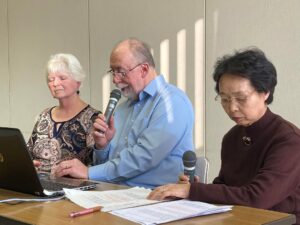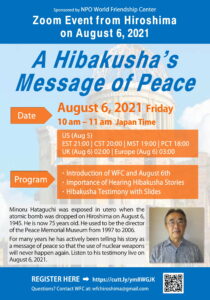WFC News
 On Saturday, November 20th, 2021, WFC participated in the “22nd International Festa.”
On Saturday, November 20th, 2021, WFC participated in the “22nd International Festa.”
The central mission of WFC, formed in 1965, has been to provide a place where hibakusha (A-bomb survivors) could give their testimonies. Last year, due to the pandemic, people could not come to Hiroshima to hear their stories. So, this year, we are bringing a hibakusha to you. We do not want another year of unheard testimonies!
On August 6,2021, 76 years since the atomic bomb was dropped over Hiroshima, we are holding an online event to hear a hibakusha tell his story.
The event will be in English with hibakusha testimony given in Japanese with English translation.
We invite everyone to sign up and join us online on August 6th.
CLICK HERE to REGISTER
—————————————-
Zoom Event from Hiroshima on August 6, 2021
“A Hibakusha’s Message of Peace”
Date/Time
Japan (Aug 6): 10am-11am
USA (Aug 5): EST 21:00 | CST 20:00 | MST 19:00 | PCT 18:00
UK (Aug 6): 02:00
Europe (Aug 6): 03:00
Program
- Introduction of WFC and August 6th
- Importance of Hearing Hibakusha Stories
- Hibakusha Testimony with Slides
Speaker: Minoru Hataguchi
Minoru Hataguchi was exposed in utero when the atomic bomb was dropped on Hiroshima on August 6, 1945. He is now 75 years old. He used to be the director of the Peace Memorial Museum from 1997 to 2006. For many years he has actively been telling his story as a message of peace so that the use of nuclear weapons will never happen again.
Listen to his testimony live on August 6, 2021.
—————————————–
CLICK HERE to REGISTER
 To all the people involved in WFC,
To all the people involved in WFC,
Thank you very much for your warm support and cooperation with the WFC.
As you all know, the number of positive cases of the new coronavirus has been increasing in Hiroshima City since early April. It is now at an unacceptable high level for the WFC; therefore, we would like to inform you of the following:
Effective immediately, April 29, 2021, all English conversation classes, events and activities will be held online only.
We will be closed for a period of time until the number of infected people in Hiroshima starts to decrease, and safety is confirmed. Please refrain from visiting the WFC and send your messages via email.
Thank you very much for your understanding and cooperation.
We hope that the new coronavirus will be resolved as soon as possible, and we sincerely hope for your safety and health.
WFC Chair, Michiko Yamane
WFC Directors, Roger & Kathy Edmark
The Tanimoto Peace Foundation, in partnership with the Hiroshima World Friendship Center, is offering an Internship Scholarship to up to three motivated individuals to come to Hiroshima for one month. The purpose of their study is to learn about, research about, participate in and write about one of the four pillars of the Tanimoto Peace Foundation: History, Peace Education, Art and Spirituality.
The internship will take place from July 4 – August 1, 2020 in Hiroshima, JAPAN.
Qualifications: The TPF Intern should be:
- 18 years old at the time of arrival in Hiroshima
- Interested in the history of Hiroshima and the atomic bomb
- Open-minded and adaptable to new situations
- Well-organized and a hard worker
- Exploring life’s questions
- Seeking peace internally as well as externally
- Recommended by a faculty member
- Familiarity with Japanese language would be useful, but not necessary
The Scholarship will include:
- Round-trip airfare from your nearest international or connecting airport to Hiroshima
- Lodging in Hiroshima at the World Friendship Center
- Per diem allowance of ¥3000 (1 approx. $30)
- Travel within Japan for research purposes
- The Scholarship will not include health coverage or transportation to your airport.
The Intern is expected to:
- Sign and meet all terms of the Contract (to be sent after acceptance)
- Reside and work at the World Friendship Center and assist them in their daily activities
- Participate in TPF four-pillar activities
- Pursue independent research related to the Intern’s area of interest
- Make a presentation of research project at the end of the Internship
- Write a ten-page report or submit an art project within one month after the Internship, reports and art project to become property of TPF
- Write a two-page evaluation of the internship program within one month of the Internship
- Become part of the TPF Alumni group
Application:
- Cover letter of introduction and CV
- Essay: “Why I want to spend a month in Hiroshima” (500 words) based on one of the TPF pillars
- Letter of Recommendation from faculty member (to be sent separately)
- Deadline for receipt of application is April 10. Interviews will be conducted online between April 15-20 and final selection by April 25.
- Application materials should be sent to rklein@gol.com
Cancellation: TPF will continue to monitor the health risks of coming to Japan and will inform accepted Interns by June 1 of the cancellation of the program for 2020.
Attachments:
Tanimoto Peace Foundation website: http://tanimotopeacefoundation.org/about/
World Friendship Center website: https://www.wfchiroshima.org/english/
Further questions should be sent to Dr. Ron Klein, rklein@gol.com
Yu-ai Friendship
Newsletter of the World Friendship Center, NPO
WFC Reflection
Natalie Kuca
(Translated by Mikiko Shimizu)
At the end of May, one of the WFC board members, Tachibana-san invited me to visit a social welfare center in the area that had history with zainichi Koreans, which was one of my fields of interests in Japanese studies. Tachibana-san had worked in the day care at the center, and he was able to arrange for the director of the center to give us a tour of the facility and tell us about its history. By the end of the meeting, my interest was piqued and I offered to volunteer at the center once a week. My first Friday at the center was a bit overwhelming and I was very nervous as no one spoke English, so I was forced to rely on my own Japanese skills. I worked with first and third-grade students in the after school program and I found that I was so nervous that I often couldn’t communicate with them in Japanese. Most of the children were shocked by my appearance and multiple students asked me whether I was Japanese and were even more shocked when I replied that I was America. They were very shy when approaching me and whispered “gaijin,” or ‘foreigner’ in small groups. Slowly, a group of girls became comfortable around me and they began to ask various questions about my family and flying on an airplane while pawing my blonde hair and staring at my blue eyes. My second Friday at the center was noticeably more relaxed as everything and everyone finally looked familiar to me. I even found that I was much more comfortable speaking Japanese as well. Granted, these were first and third-grade students, but my comprehension of their fast-face Hiroshima dialect had significantly improved.
Additionally, on the third Thursdays of both May and June, Yovana, Barb, Dannie, and several WFC board members volunteered at a hibakusha retirement home. The first day at Mutsumien was enjoyable because both Yovana and I were able to introduce ourselves in Japanese on the stage and then were able to watch Hawaiian hula dancing by a local amateur troop. For June, the chairwoman of the WFC, Michiko-san asked us to prepare a small activity for the members of the retirement home. Naturally, Yovana and I decided on bingo, which is an enjoyable gave for people of all ages. We prepared three small prizes for the winners and had a lot of fun shouting the numbers in Japanese and cheering for the winners. The grannies were so excited when they won their WFC pens as they weren’t expecting anything as a reward.
Yovana and I were entrusted with an important responsibility during our fifth week in Hiroshima. The co-directors had planned to take this weekend off and left Yovana and I in charge, and we were very honored by their trust in our abilities. Barb and Dannie left on Saturday morning, but Yovana and I prepared breakfast for nine people all by ourselves. Luckily, Leona and Maila, along with their mother, Mirei, were staying at the WFC for a performance that weekend and were able to help relieve our anxiety and took some of the pressure off being in charge. We were able to prepare breakfast with no problems, and had incredible discussions with our Californian guests during the meal. The easy-going nature of this group of guest was a great relief for everyone, and we were able to proceed with the weekend with minimal issues. The groups’ scheduled hibakusha survivor, Soh-san gifted us with his handmade fans and handcrafted wooden pencils made from his own cherry trees. His generosity exemplifies the overall compassion and generosity everyone at the WFC has shown us. Yovana and I have taken to calling the board members of the WFC our sweet grannies because they constantly spoil us with fun conversations and stop in to give us fruits and sweet treats.
In addition to our Monday and Tuesdays at Shudo University, we also join in on a WFC English class on Wednesdays. I have been particularly impressed time and time again with the proficiency and fluency these students demonstrate every class. Their class begins by a presentation made by one of the students, which oftentimes include history of post-war Hiroshima or their family member’s experiences during the bombing in English. This class in particular maintains a mandatory break where they serve tea and they share snacks with one another. The second half of the class includes the reading of an autobiographical account of Shinzo Hamai, the mayor of Hiroshima that fought for reconstruction, again in English. I find that this type of learning is especially effective in helping students with retention of new vocabulary and comprehension. In fact, I have become so inspired by this technique that I am planning on purchasing a couple of Japanese books and trying to translate and read these novels on my own.
Yovana and I were given the incredible opportunity to hear ten hibakusha testimonials. These testimonials detail accounts of the same humid early-August morning seventy-three years ago, but the experiences of each hibakusha and the lessons and challenges they confronted all manifested in different ways. Their powerful and emotional stories forced me to realize the importance of denuclearization movement. When I was learning about the Pacific Theatre of WWII in high school, I was under the impression that the atomic bombings of Hiroshima and Nagasaki were irrevocably necessary to bring an end to a decade of war in Asia. During a discussion in history class, I had even taken the side of the American government and stated that the bombing had been necessary. The real problem for most Americans is that the education on the end of the war with Japan is incredibly biased. The Japanese citizens are painted as ferociously devoted to their emperor and their militarist government that, in the case of an American invasion, the women and children would attack American soldiers with bamboo spears. America argues that millions of young American lives would have been taken in the fight for Japan and they claim that Hiroshima and Nagasaki are demonstrations of what would have happened to all of Japan. In history textbooks there is little to no mention of the fire-bombing of the two dozen largest cities in the months leading up to American encroachment of Japan. During these bombings, hundreds of B-24s and B-29s razed cities to the ground until they resembled the images of Hiroshima and Nagasaki that textbooks like to point to as a demonstration of American power. The difference between the fire and atomic bombings is that the latter were carried out by a single bomb, rather than thousands of them. These history books also fail to mention that the American navy had completely encircled Japan, preventing the import and export of valuable resources for their citizens and soldiers on both sides. Though students were mobilized to farm food and other resources in the countryside, and were often trained to resist possible invasion with bamboo spears, Japan was starving and women and children were dying from malnutrition at the time of the atomic bombing. Furthermore, the physical devastation of the atomic bombings, not including the unknown devastation of radiation posioning, was almost identical to the thirty other large cities in Japan that were fire bombed. The atomic bombings of Hiroshima and Nagasaki, I have learned, were not as conclusive of Japanese defeat as our history books claim. The radiation, which effects come later, is the most devastating outcome of nuclear warfare and nuclear disasters.
The resilience of the hibakusha, and the rest of Japan after the war, was particularly inspiring to me. Though the bombing and its effects were harrowing, the survivors survived because they were all able to find something and someone to continue living for. I believe that such devastation is an important piece of survivors, but it does not consume their entire soul, there are many more pieces that create who they are and how they choose to live their lives. All the hibakusha have maintained that they wish for worldwide peace and for complete global denuclearization, not to compensate themselves but in order to prevent more people, more innocents, from suffering from the inevitable devastation nuclear weapons and nuclear disasters present.
As we began our last week in Hiroshima, Yovana and I both found it difficult to imagine going home when we were so in love with Hiroshima. The people we have met here have made everlasting impressions and the history we have learned here will continue to persuade us into peace activism in our communities back in the States. I have grown a lot during this internship and am eternally grateful for the opportunity I have been granted and I will work hard not to squander it.
Copyright © NPO World Friendship Center 2019 All Rights Reserved